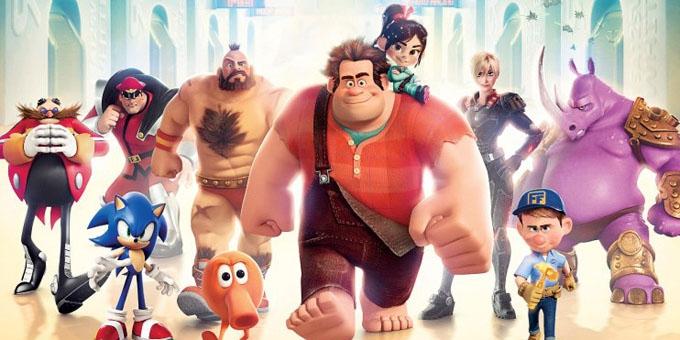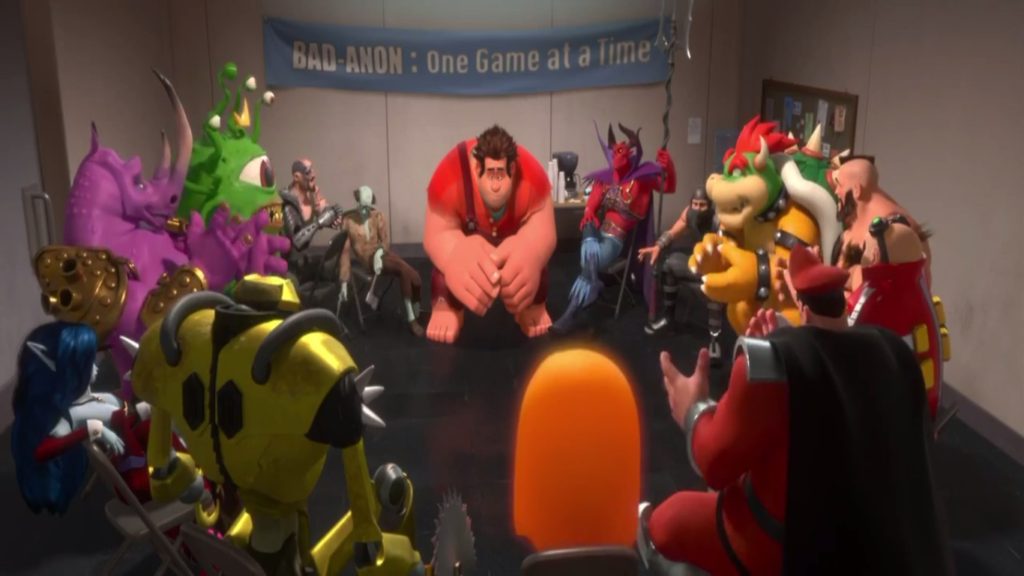Disney Game-Changer Earns a Medal
DIRECTED BY RICH MOORE/2012
 “Wreck-It Mouse”. For whatever unknown reason, that’s the zinger that my two year old son unleashed on his slightly older siblings who actually got to see the movie. The kid-laughter that followed was stronger and more intense than any they generated for Wreck-It Ralph itself, but never mind that right now. The movie is great. A lot of fun, even when it gets a little too caught up in itself. It’s likeable; complex but always approachable, smart but never intimidating. It is both nostalgic and contemporary, edgy and traditional. In the ever-lengthening line of sharply-tinged computer-animated family-friendly pantheon of villains-as-protagonists (Despicable Me, Megamind), Ralph is the most immediately empathic, the warmest of the bad guys who deep down, want to be good.
“Wreck-It Mouse”. For whatever unknown reason, that’s the zinger that my two year old son unleashed on his slightly older siblings who actually got to see the movie. The kid-laughter that followed was stronger and more intense than any they generated for Wreck-It Ralph itself, but never mind that right now. The movie is great. A lot of fun, even when it gets a little too caught up in itself. It’s likeable; complex but always approachable, smart but never intimidating. It is both nostalgic and contemporary, edgy and traditional. In the ever-lengthening line of sharply-tinged computer-animated family-friendly pantheon of villains-as-protagonists (Despicable Me, Megamind), Ralph is the most immediately empathic, the warmest of the bad guys who deep down, want to be good.
I’m no gamer, but I do know this: With its of-the-moment video game concept, Wreck-It Ralph is, in terms of attitude and approach, the most of-the-moment Disney animated feature film yet. (Take that, Oliver & Company!) And make no mistake; this is Disney proper, not Pixar, a company that it owns, but a still-separate creative entity. It’s an understandable mix-up, especially considering that this year’s Pixar film (Brave) looks a lot like a Disney movie, and vice-versa. Pixar has always been more boy-centric (with its Cars and Buzz Lightyear and whatnot) while Disney animation has functioned well within the comfort zone of younger girls. (Look no further than their stable of brilliantly marketed princess characters.) Naturally, in the global market, being what it is, there’s an understandable internal need for these companies to break out of their niches, to go further in their reach. The fact that they are doing so in the most creatively satisfying ways possible goes quite far in paving over the vast corporate synergetic yuck of it all. If the Mouse is out to wreck anything here, it’s its own collective perception. As Ralph would say, “They’re gonna wreck it!!!”
This expectations-wrecking continues into the casting, with an impressively eclectic array of voice talent. With John C. Reilly in the lead as the title character and Sarah Silverman co-headlining as the spritely, smart-mouthed Vanellope, a vagabond exile in her own candy go-cart game (“Sugar Rush”), discriminated against due to a programming glitch (beneath the metaphor, the glitch is a functional medical condition she lives with).

Just a Sugar Rush!
When Vanellope first meets Ralph, slyly asking him if he’s a hobo, it is, in its own way, as inappropriately hilarious in its family/Disney/PG-rated sphere as Silverman can be when going true blue for adult audiences. It may be just a little over the line, but just enough to be cool, not actually “dangerous.” While the Disney traditionalist in me hopes that this sort of thing does not become their norm, it truly works for Wreck-It Ralph. Also sweetening the pot are Jack McBrayer (30 Rock) as Fix-It Felix Jr., Jane Lynch (Glee) as an awesome tough-as-nails Halo-esque space marine, and fanboy idol Alan Tudyk (Firefly) as the unforgettable oddball antagonist King Candy. (“Have some candy!!!”)

“Aw yeah! Here comes diversity!”
Wreck-It Ralph is darn near brilliant for the perceived storytelling ease that’s apparent while it explains its complex world of the inside of video games in its particular video arcade (in this sense, it is the anti-Tron); how game characters have their own lives outside of their “day jobs” of being “played”, and can leave their games and enter others (each beautifully rendered and accurate to the established logic and technology of its genre/born-on date), crossing through a bustling “Game Central Station”, i.e. the power strip they’re all plugged into. This allows for Wreck-It Ralph to momentarily be a sort of Who Framed Roger Rabbit for video games (said before, but very true), treating audiences to a bustling array of characters both newly made up for the film as well as many known classics, their likenesses smartly licensed by Disney from numerous other companies. Pac-Man, Street Fighter warriors, Q-Bert, and Sonic the Hedgehog, among others, all make fun cameos.

Game villain group therapy.
Interestingly, Wreck-It Ralph offers a unique degree of non-overt social commentary, just beneath the surface. The game “Fix-It Felix Jr.” is, by design, “Donkey Kong” with a very vaguely uncomfortable 1980s xenophobic class-ism. (Something still very much alive in the world today, as enlightened as we may think we are.) Ralph is the impoverished “other”, only a problem when he leaves his prescribed home (the brick dump, and his tree stump) to wreak havoc on the nearby penthouse apartment building, his very presence invoking destruction. This is a world (granted, a simplistic construct currently celebrating it’s thirtieth anniversary in the broader world of Wreck-It Ralph) where the impoverished “other” is nothing but a threat that ultimately must be driven out, thrown off the roof into a mud puddle at the end of every winning game.
The hero, Fix-It Felix Jr., is at a glance a blue-collar everyman who works tirelessly chasing Ralph’s messes, instantly repairing them with magic hammer. A virtuous character, to be sure, but even with Felix, we come to find that his job, his hammer, his whole existence, was handed down to him from his father (no doubt a first generation game that was supplanted with a glossier upgrade, ala “Ms. Pac-Man” or “Donkey Kong Jr.”), his heroics just a habitual nature, his virtue a far cry from his milquetoast personality.

8-bit brute!
Ralph himself, by contrast, is a brutish-looking aggressor, an 8-bit Andre the Giant whose disproportionate appearance (his insanely large hands, his crazed mused hair, his caveman-like fashion sense) is intended (by the non-existent creators of the game, not the movie proper) as freakish. Although the film’s story resolution may not embody the kind of revolution this lopsided construct of reality needs (guess there’s always the sequel!), Ralph’s quest – to be seen as a hero – is the journey it settles for. His arc is one born of woe-is-me self-interest, rife with good old fashioned class envy.
Every classic Disney protagonist has an “I wish” moment up-front, informing the viewer of what it is he or she longs for in life (be it love, rescue, belonging, what have you). For Ralph, his longing forsakes the destructive rage he was programmed with, giving way to an internal desire to belong with the upwardly-mobile, the “comfortable”. For some, this is a form of “the American Dream”, a woefully amorphous notion these days. For Ralph, getting a medal is everything. (Then these cushy penthouse dwellers will see him as someone important!) What Ralph finds is a more conventional lesson – that the label of “hero” cannot be easily awarded.
On an even deeper level, Ralph’s want to be good in spite of his own foul inner programming rings true as a deep-seated fact of the human condition, just as his logical but shallow attempt at essentially buying his way into the perceived “good side” (by getting a medal) is nothing but cheap grace (if that), tantamount to scraping together enough money to join a posh country club. That Wreck-It Ralph dares to explore these challenging avenues, albeit in an audience-friendly under-the-radar manner, is, frankly, medal-worthy in and of itself. Someone bake this movie a pie!

Ralph and Felix, making time at the Kingdom.
And yet, Wreck-It Ralph doesn’t travel nearly as far out of the (theme) park as it may want people to think it does. That gag-worthy take-away of so many humanistically pious contemporary family movies, the “follow your heart” denouement, is present in some form here. Additionally, Disney’s latter-day skittish need to blend their female leads’ quasi-feminist outlooks with the princess fantasy that the studio itself has cultivated and perpetuated (think Tiana in The Princess and the Frog, or Mulan) continues even in this boy-centric adventure yarn.
None of that is a game ender for me. Being a proponent of properly applied Disney traditionalism, Wreck-It Ralph passes muster. With it’s recognizable pop music, game world channel changing, and edgy voice talent, it is very much a new-fangled approach for the studio, but it’s not as far out as all that, either. (It’s also available in 3D, which is fun but not essential.) In any case, one has to respect a company’s willingness to veer out of its well-established comfort zone, even if it is, in large part, in the name of bottom-line business sense and the dollar-driven need for an expanded audience base. (I can just hear the boardroom logic: “Toy Story hands-on toys are old hat, now the kids only love video games!!”) But if corporate agendas bother you, best to stop watching movies altogether. As Wreck-It Ralph displays, such mentality can pay off for filmgoers when the massive global entity in question realizes the value of its audience, and strives so hard in so many clever directions to get it right. Disney, like it’s latest protagonist, may’ve been motivated for lesser reasons, but in the end, the journey was the right one.
So to that I say, wreck it, Mouse.

